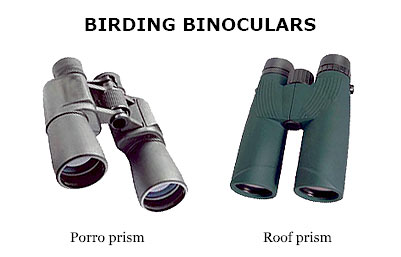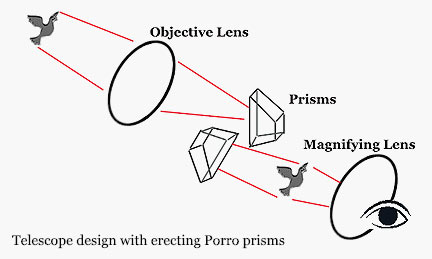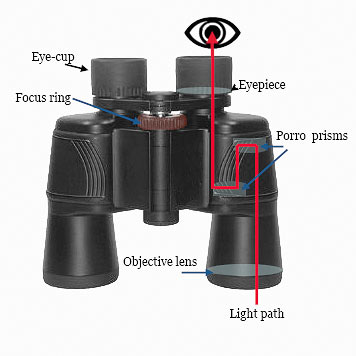by Mr. Sumit Sen
One of the best things about bird-watching is that you require very few tools and consequently very little investment to enjoy your hobby. A good illustrated bird field guide book, a notepad and a good pair of binoculars or ‘bins’ as many birdwatchers call them, are all you may ever need to become a bird-watching enthusiast.
Binoculars are what you see your subjects of desire through and are, therefore, a key tool and investment as bird-watching is all about watching birds. As binoculars are available in all sizes and shapes and can range from excellent to pathetic, it may be worthwhile to know a little bit about them before making such a critical investment decision.
What is a binocular?
Binoculars are viewing tools that can magnify distant objects and bring them visually closer to us. In simple terms, they are two telescopes mounted side by side, one for each eye. A basic telescope has two magnifying glasses placed in line at a fixed distance. The front glass is the objective lens and the one near the eye is the eyepiece. As telescopes invert images, binoculars require a third element – an erecting prism to flip the image for us to enjoy a naturally magnified view of objects.
How to choose a binocular?
Magnification and light gathering
All binoculars, and certainly those that can be used for birding, have two numbers with a cross (x) between them: 7x30, 8x40, 12x50 etc. The 1st number is the magnification that the binocular offers and a 7x binocular will bring objects 7 times closer to the viewer compared to the naked eye. The 2nd number (x30, x40) is the width of the objective lens in millimeters. The objective lens is the largest lens in the binocular and its size determines how much light the binocular will let in and how much of the scene you can view. Obviously, a large objective will allow more light to reach your eye than a smaller one.
So, an 8x40 binocular magnifies objects eight times and shows you a brighter and broader view than an 8x30 if they are of identical design otherwise. What that means is that you will find the 8x40 showing you more details that the x30 when the light is poor – something that happens very often with birds.
Higher power does not mean better bird-watching. High powered binoculars are heavier and difficult to focus with. Large objective size also adds to the weight but may resolve less detail. Today superior coating often helps smaller objective lenses to gather more light than uncoated larger ones - less reason to carry heavy bins.
The most recommended birding binoculars usually have a magnification of 8x though some prefer the 7x versions. The maximum recommended magnification for birding binoculars is 10x and only the very experienced use it. Optimum objective size depends on the eyepiece design and quality of coating. High-end binoculars, usually costing over28,000/=, can gather enough light for difficult condition bird-watching at x30 dimensions. More affordable binoculars usually need a 36mm objective diameter to function well in dim light conditions.
Recommended size: 8x36 or 8x40 for good quality birding binoculars.
What else do we look for when buying a birding binocular?
1st and foremost – "try it" and compare with similar models. The feel is very important.
Weight: The lighter the better – makes it easier to hold them steady and carry for long hours. Anything less than a kilogram is good.
Balance: Balance may be more important than weight. When selecting a binocular see how it handles and take the one that is most comfortable to hold. This should result in very little stress on your arms, wrists and hands over long hours of use.
Exit pupil: This is the size of the image at the focusing point of the binocular. It is computed by dividing the objective size by the magnification. The exit pupil of an 8x40 binocular is 5mm (40/8). A larger exit pupil means a brighter image. Binoculars over 3mm are considered good for daytime birding and anything over 7mm is a waste.
Eye relief: Eye relief is the distance from the rear eyepiece lens to where the image is formed. Eyeglass wearers should look for binoculars with at least 15mm of eye-relief and have eye-cups that can be folded down. This will allow them to enjoy bird-watching.
Close Focus: Good birding binoculars should have a close focus of 10 feet or less otherwise you may find yourself walking backwards to try and see something. How close a binocular focuses depends on how it is made rather than on its power.
Body Design: There are two basic types. i) Porro prism Binoculars and, ii) Roof prism binoculars. Roof prisms are lighter, rugged, easier to maintain and usually waterproof. Porro prism binoculars are cheaper, have a wider field of view and are more easily available in India. Optical quality is not markedly different though roof prisms being more expensive usually have better coating.
Weatherproofing: Binoculars can range from no weatherproofing to waterproof to nitrogen purged. Regular birders should look for nitrogen purged waterproofing, especially in a humid place like India. Nitrogen purging keeps out dust, sand, or anything else that can get inside the binoculars - most importantly ‘fungus’. Weatherproofed bins are often expensive, so this is ‘good to have’ and not essential.
Coating: Multi-coated provides the best optical quality but can increase the price – get what you can afford.
Brands: Binoculars are often treated like a fashion item and hanging a Swarovski binocular in the field is akin to wearing a Rolex watch to a meeting. But like a HMT or Timex gives the same time as the Rolex at a fraction of the price, a good pair of Bushnells may show the same view as a pair of Leica Ultravids, again at a fraction of the price. But there is always more to price differences than brand names alone, so to each his/her own! Here are some choices:
Most desirable: Swarovski, Leica and Zeiss - starts upwards of40k
Medium range: Nikon, Bushnell, Pentax - wide price range
Cheaper alternatives: Olympus, Swift, Eagle Optics - often in the less than5,500/- range
Some recommended starter models available in India:
Pentax PCF WP II 8x40 (Porro)
Nikon Action 7x35 (Porro)
Nikon Action 8x40 (Porro)
Nikon Sporter I 8x36 (Roof prism)
Olympus 8x40 DPS I (Porro)
Bushnell Falcon (Porro)
Prices start at3,500/= and the Nikon Action Series is priced at around
7,500/=. The Pentax PCF can cost around
8,500/= but is nitrogen purged.
What not to buy
Opera glasses, cheap Russian binoculars, brightly coloured cheap objective lens binoculars, high magnification compacts like 10x21mm bins. Zoom binoculars are not considered to be suitable for birding. Also stay away from stabilized and camera fitted models.
Binoculars are what makes bird-watching pleasurable - so invest in the best that you can afford, they are sure to give you years of memorable moments!


